New mill grinds down costs and boosts efficiency at Savage River

Inside Grange Resources Savage River magnetite concentrator in north-western Tasmania. Upgraded mill to the right of Metso’s Steve Searle & John Aran
Grange Resources Limited owns and operates Australia’s largest integrated iron ore mining and pellet production facility and is the country’s oldest magnetite producer. Located 100km southwest of Burnie in north western Tasmania, is the company’s Savage River magnetite iron ore mine and concentrator.
An overview of the “from mine to metal” process at Savage river, starts with the crushed, stockpiled magnetite ore being transported via a tunnel system and fed into the concentrator. Here the ore is initially ground in two Hardinge 9.75 x 3.66 metre autogenous(AG) mills, followed by two Nordberg 8.84 x 3.96 metre ball mills. Magnetic separators then isolate the magnetite from the gangue (valueless adhering rock), with the fine-particle gangue being pumped to tailings dams. The rich iron concentrate slurry is pumped via an 83km pipeline to the pellet plant at Port Latta.
The company ranks the reliability of product supply, quality, and volume, combined with aggressive pricing, as vital interdependent ingredients to successfully operate in the highly competitive iron ore market. Wayne Peck, Grange Resources’ Engineering Superintendent, explains, “From an operation perspective each of these factors have to be consistently met, with little margin for error. Starting from the pit, right through to the end of the ship loader, our customers’ requirements are our focus – ‘from mine to metal’ as we say. Reliability of supply depends on the performance of our personnel and the processing equipment they use; whilst remaining price competitive depends on keeping our costs in check. Energy is our biggest cost, and an area where even small changes can have a big impact.”
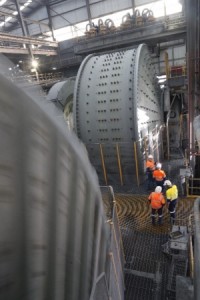
The two Hardinge AG mills, with the refurbished mill in the background
A need to upgrade
The two Hardinge AG mills were originally installed in the late 1960’s, and by 2005 maintenance personnel noticed cracks starting to appear in their shells and cones. The mills required ongoing repairs which resulted in plant down time and there was always the risk of a catastrophic failure. With the mine’s operation expected to extend till at least 2034, Grange’s management team decided that in order to ensure concentrator reliability and to improve output efficiency, these mills would need to be upgraded. In 2011, the company awarded Metso an $8M contract to engineer, supply, install, and commission the first of two planned new mills.
The project scope involved increasing production volume with a new rotating element that would accommodate a charge weight of 344 tonnes, but with the requirement to use the existing footprint and some of the components from the original 1966 mill. This specific requirement introduced a great deal of complexity to the design. A high level of detailed analysis to assess the impact of increased stress due to the new larger rotating element was required. A key to the success of the project was the review of the bearing housing structure and ensuring adequate lubrication.
Contract Award
Metso’s overall experience in mill design and manufacture has been accumulated from the companies that it acquired over the years. Hardinge was one of these acquisitions, so Metso had the original design drawings as well as extensive experience and intimate knowledge of these mills. The plant’s Nordberg ball mills are also a Metso product. The company’s expertise held it in good stead to take on the project.
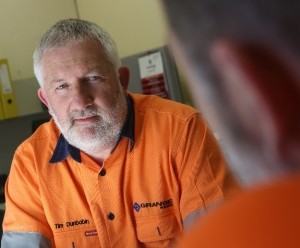
Tim Dunbabin, Grange Resources’ Senior Project Engineer
Tim Dunbabin, Grange Resources’ Senior Project Engineer, comments on the decision to award the contract to Metso: “Our engineering team had done a great job of extending the mill’s 20-year design life to over 45 years. So whilst there is no doubt that the mill was at the end of its life, we mainly needed better reliability and efficiency.
“Metso had been involved in many of the repairs to the old mills, and so, we had first-hand experience of their expertise, capabilities and service levels. This, together with the Hardinge mill design being Metso’s intellectual property, really helped to mitigate our risk.”
Wayne Peck cites Metso’s ability to offer a complete package as a key deciding factor. “Whilst we were familiar with Metso’s capabilities, for me the main decision lay in the overall package. Although other suppliers had the elements of good expertise or comprehensive equipment supply, when we looked at Metso we had the whole project covered. If we had an issue, we would only need to direct questions to one point of contact.”
Unique design constraints
The original mill was based on a single shell design, and although it had lasted more than 45 years, the new design had to be stronger to ensure trouble-free operation beyond the mines expected lifespan of 2034. So in the first instance, Metso’s new design replaced the single cone-shell with a two-piece structure that was 3.6 metres wide (distance from feed to discharge) and featured long-life Polymet rubber liners. To provide sufficient space for these liners, the new mill had to be 10 metres in diameter, 30cm larger than before. The larger shell, together with thicker stronger steel construction, meant that the new mill was 20% heavier than the old one.
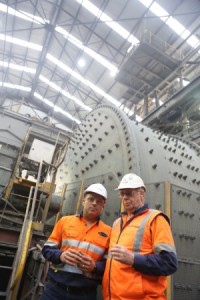
Metso’s John Aran discusses mill performance with Frank Lovell, Grange Resources’ Engineering Manager
In order to avoid the need for additional civil works and to keep costs down, the new mill had to be installed in the same position as the old one. To ensure that the existing structure could accommodate the extra weight and size of the new mill, Metso had to perform extensive FEA’s (finite element analysis) and carefully consider alternate designs.
Key to the successful design of the new mill, was the ability of the mill’s bearings to cope with the increased weight. A simple overview of the bearing components helps to explain how important this aspect was. Starting from the centre and working outwards, first is the trunnion, the shaft that extends out on both side of the mill and which passes through its axis. The trunnion rests on a bronze bush that provides the bearing with its crucial lubrication. The bronze bush is supported inside the bearing housing by the rocker. As its name suggests, the rocker allows the mill very small lateral movements from side to side along its spin axis. Important to note is that the trunnion rolls in a 0.2-0.4mm film of oil that is pumped at high pressure through ports in the bronze bush.
Because no civil work could be considered, stiffening the bearing could only be achieved by thickening the rocker and the brass bush. The increase in load and reduction in bearing clearance meant that the force per unit of area (pressure) increases. Then of course there was the additional weight that also had to be taken into account
John Aran, Metso’s Grinding Product Manager, explains: “Making it strong enough was the easy part, next we had to design a lubrication system that would keep the trunnion suspended above the bronze bush with a 0.4mm thick oil film. There are no off-the-shelf designs for this, so designing an effective and reliable lubrication solution that included a custom-built cooling and filtering system, involved input from Metso’s experts across the globe.”
“Just imagine pumping oil at 10,000 kPa at a rate of 15 litres per second to achieve a 0.4mm thick film that needs to lift and support a rotating element 10 metres in diameter and weighing over 500 tonnes on each bearing. There are so many interdependent variables, providing a solution to this unique arrangement gave us all a great sense of achievement.” He said.
The base plates that the mill’s bearings sit on, also presented an engineering challenge; they had a flatness tolerance of 0.13mm over the entire surface, with a 0.025mm tolerance over an area of 300 x 300mm. The parallelism tolerance between the top and the underside surface was just 0.13mm. Such precise tolerances are even difficult to achieve in a controlled environment like a machining workshop. Brian Bunch, Metso’s QA Engineer, explains, “Because all the work would be carried out in the field rather than in a workshop, I was keen to see how closely the team would achieve these tolerances in an operational site environment where the base plates had to be positioned using site surveying equipment. The attention invested into these fine details by the project team, resulted in an almost effortless installation. Once the sub-sole plates were aligned correctly, the base plates were lowered into position and there was no need for any shimming or additional “tweaking” to attain the required flatness.”
Engineering challenges
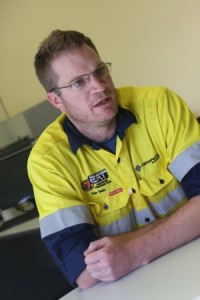
Dan Tonks Grange Resources’ Projects Design Engineer
Dan Tonks, Grange Resources’ Projects Design Engineer, was deeply involved in the design aspects of the plant’s infrastructure upgrade which had to facilitate and perfectly match the new mill’s design. Talking about the design challenges he faced, Dan says, “It might sound straight forward, but the infrastructure upgrade consisted of components sourced from different manufacturers located all over the world. Together with Metso, we invested in a lot of interactive and iterative planning to make sure everything matched up. An error in the most minor detail, for example bolt-hole sizes, could be a disaster for the project. So there was a sense of pride, and relief too, when everything came together and matched up so perfectly,” he says.
Work space during the dismantling of the old mill and the construction of the new mill was a major challenge. Frank Lovell, Grange Resources’ Engineering Manager, comments: “Originally the mill was built first and then the building was built around it. So working on removing the old mill and installing the new mill within the existing building presented major restrictions. We had lifting weight and size limits, as well as difficult work access. The fact that the whole project was completed without a single safety incident is a credited to the way Metso’s design addressed these construction complexities.”

Steve Searle
Big wins for efficiency and safety
Talking about the success of the project, Steve Searle, Metso’s Regional Manager for Mining Services says, “Metso didn’t just supply the components and technical expertise for the installation, we were an integral part of Grange’s engineering team. This approach makes such a big difference on a project like this. We worked through all of the issues together to ensure that the installation ran smoothly and on time. The installation process was developed with the Grange team, and we performed each operation as a unified team. The outcome is a new mill, which together with the new drive system, will provide the plant with 19% more capacity.”
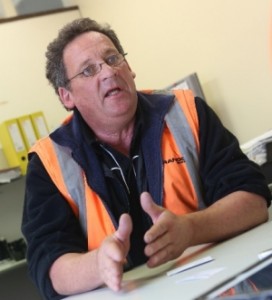
Wayne Peck
Wayne Peck also highlights how the close inter-company team work maximised efficiency and cost reductions. He says, “Working so closely together on the project meant that Metso could assist us to look at the design of the project as a whole, not just to consider the quickest or lowest cost solution, but to look at improving quality and throughput, reducing running costs, and overall long term maintenance.”
Dan Tonks, the Project’s Design Engineer reviews the outcomes of the project: “Efficiency is a big benefit that has been gained from this project. The mill is now grinding more, using the same power. Equally as important for Grange, are the safety benefits that the new mill has provided. In particular, both our staff and contractors have praised the new mill’s better overall access and larger size work area. The guarding on the rotating elements is greatly improved and easier-to-handle. In my view, the project receives big ticks for safety, efficiency, and cost reduction.”
Fore more case stories with Metso solutions, please visit http://www.metso.com/showroom/
{{ commodity.name }}
{{ post.title }}
{{ post.date }}
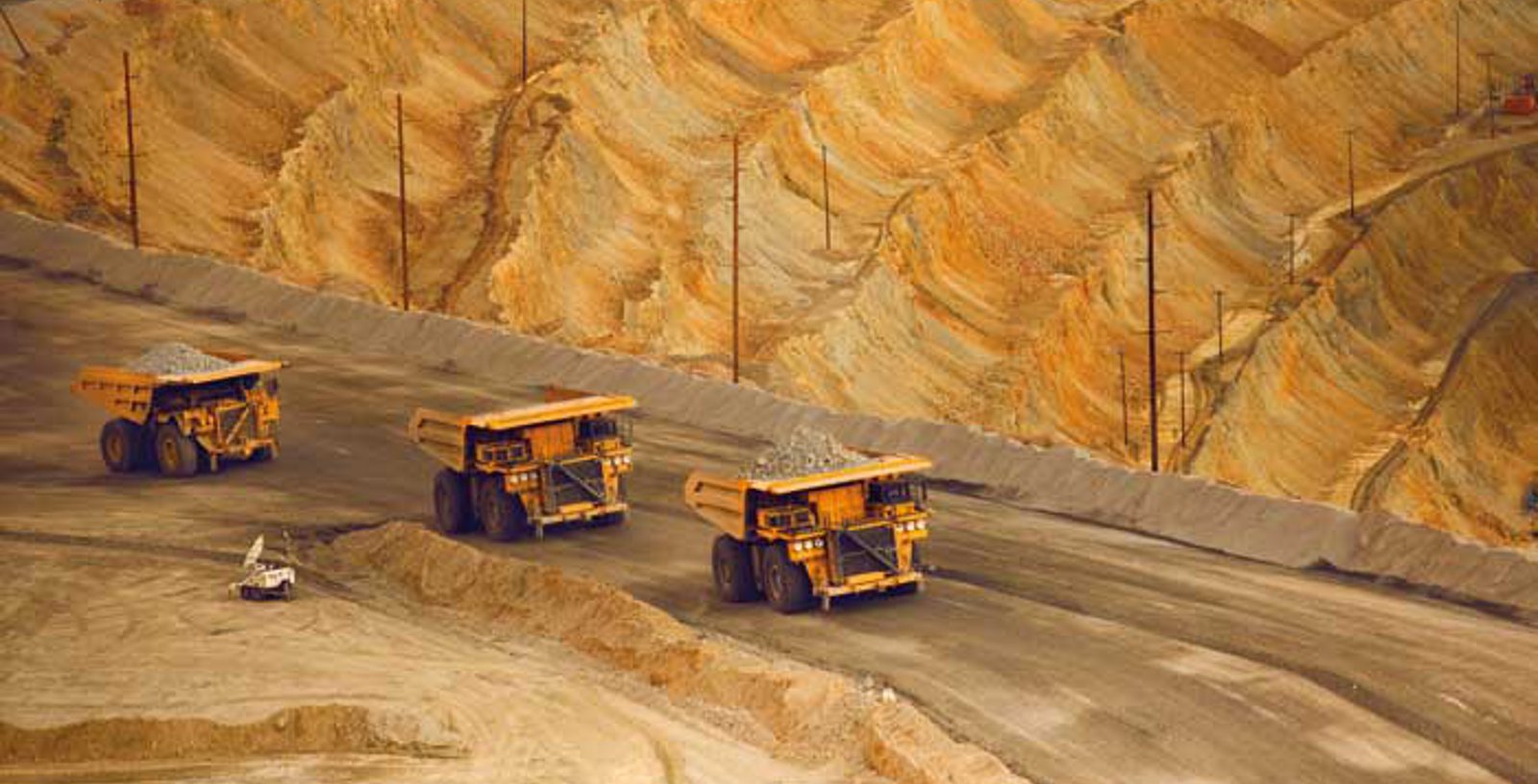
Comments